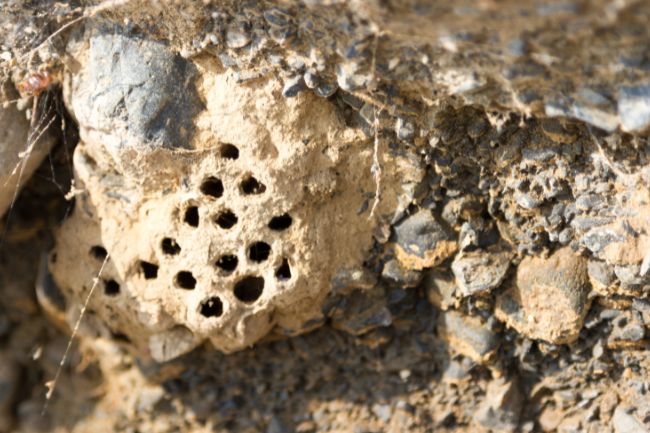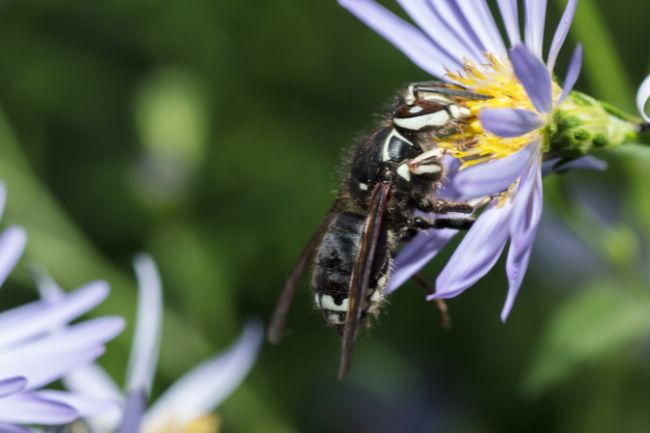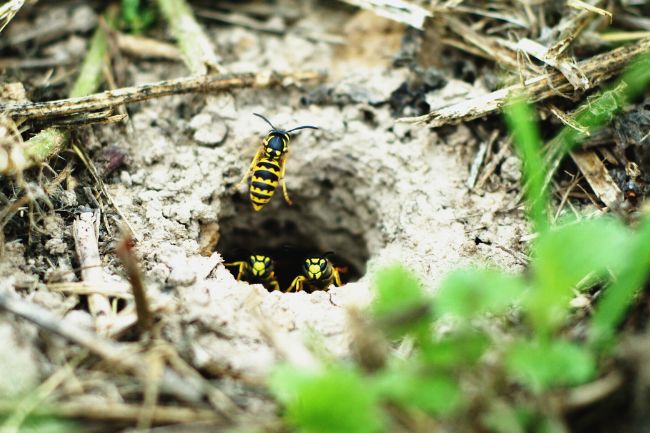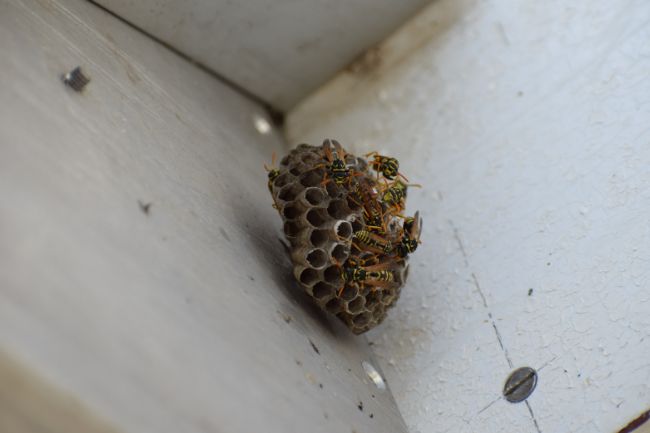Many people mistakenly think that hornets nest underground, however, this is largely because they are easily mixed up with ground-nesting wasp species.
This article looks at the fascinating world of hornets, including where and how they nest.
Types of Hornets and Their Nesting Preferences
Hornets are often confused with other types of wasps, due to their similar colours and markings. Yet, while they are a type of wasp, they’re separated from them by their wider heads and larger more rounded abdomens. Hornets also tend to be larger than many wasp species, giving them a particularly voracious reputation.
There are around 22 species of hornet found across the world, with most of these being native to asia. Hornets belong to the genus Vespa, however some species of wasps are mistakenly given the common name hornet, such as the bald-faced hornets.
Due to their similarity, it’s not uncommon for observers to confuse hornets and wasps. While there are only 22 species of hornet globally, there are around 30,000 species of wasp. While we tend to know more about the eusocial species, those that live in hives, over 99% of wasps are solitary. Many of these solitary species of wasp nest in the ground, in soil or sandy banks, making it easy to think that hornets might do the same.
Two wasps that are often mistaken for hornets are the bald-faced hornets and ground hornets. While ground hornets are a type of wasp that nests in the ground, within the true hornet family there’s only a few that are known to nest in the ground. The oriental hornet, for example, builds its nests largely underground, though it does also sometimes use aboveground sites such as hollow trees.
| Hornet Species | Preferred Nesting Location | Nest Characteristics |
|---|---|---|
| Eastern Yellowjacket | Underground burrows, abandoned rodent nests | Papery envelope inside cavities, multiple combs |
| European Hornet | Tree hollows, building voids | Papery envelope inside cavities, single comb |
| Common Aerial Yellowjacket | Ground burrows, rock crevices | Papery envelope inside cavities, single comb |
| Bald-Faced Hornet | Tree branches and shrubs | Large, gray, paper envelope hanging from branches |
| Northern Paper Wasp | Eaves, fences, porch ceilings | Open-celled paper nest attached to surfaces |
Also read: What Bee is all Black? (A List of 7 Species)
Above-Ground Nesting Habitats
Most hornets make their nests from paper, something they form by chewing on wood fibers and then regurgitating the pulp. Their saliva helps to make the nesting material waterproof. The nest is made up of hexagonal cells, in which the young are reared. The whole structure is then covered over by an outer layer to protect it from the elements. All this fine work is carried out by the hornets using only their mandibles, which is an amazing feat. The nest generally has an opening at the bottom to allow the hornets to enter and leave, without water coming in.
As the hive grows the nest will be extended, allowing for more space. Like wasps, only young queens survive the winter, going on to form new nests, while the old worker, males and queen all die. The nest itself is abandoned, but can stay intact for long periods of time due to its amazing construction.
Hornets are perhaps the most feared of the wasps, mostly because of their larger size and frightening stingers. Although they have a fearsome reputation they are relatively gentle creatures, and don’t attack unprovoked.
Because of their large stings and the misconception that they are aggressive, people mostly don’t want to have hornets near their homes, yet it’s not unusual for these busy insects to set up home in buildings, sheds or even cars. Mostly however, they tend to prefer trees for their nest location, ideally somewhere high up and secure.
Hollows in trees can be particularly beneficial as they have added protection from the elements. Failing the provision of a reasonable tree they may nest in shrubs, or even rocky areas, such as beneath the overhang in cliffs.

Also read: Wondering “Where do Fireflies Live?” (Explained)
Misconceptions About Ground Nesting
Solitary wasps are species of wasps that live alone, rather than in a hive with their relatives. This doesn’t mean that they won’t nest near others of their own species, and some will live in large congregations within one area, however, these little wasps have nothing to do with each other when it comes to nest building and stocking.
Solitary wasps may dig into the ground, to form burrows or chambers. Here they will deposit their eggs and the food to sustain their young after they’ve hatched. With some species this will even be large prey that is dragged into the underground chamber alive.
It’s not surprising then that many solitary wasps flying in and out of one area might lead observers to think that there’s a hive, and that all the wasps are working together to raise their young. Adding to this confusion is of course the misuse of the word ‘hornet’ applied to solitary wasps that are particularly large or hornet-like in appearance.
Although the oriental hornet does nest underground, most other hornet species prefer their life above ground. This may be in part because digging the soil is hard work, and there are risks from flooding during heavy rainstorms. Their larger size may also make living underground more difficult. With their stingers they are also easily able to put off any potential predators that might spot them in their aerial nest, making it less risky for them than some less weaponised insects.
Also read: Centipedes at Night: What Do They Do & Why Do They Prefer it!
True Ground-Nesting Hornets: Baldfaced Hornets
The bald-faced hornets are a species of wasp that is found around Canada and North America. Its name stems from its distinctive colouring, which is white and black, making it appear bald. It is eusocial, like true hornets, building paper nests that largely hang down from tree branches.
Its hornet label is probably due to its similarity in appearance to the European hornet, which has been introduced to North America, but is not native. It’s often praised for its habit of eating pest species, such as caterpillars and flies, but its reputation of being aggressive means most people don’t like to have it close to where they live.
Like hornets the bald-faced hornets tend to nest high up, hanging their paper nest from tree branches, or overhanging rock faces. As with other wasp species they begin to build their nests at the start of the season, and then abandon them as they die off in the winter.

Ground-Nesting Wasps vs. Hornets
A large number of wasp species nest in the ground, such as digger wasps. Digger wasps can dig tunnels up to 30cm (12 inches) in length, with several chambers branching off at its end, one for each offspring. Digging deep burrows can regulate the temperature, which stays more stable further away from the surface.
Unlike hornets solitary wasps don’t bother making paper, as their nests are usually composed of whatever they are nesting in, such as soil or wood if nesting in hollow branches.
Unlike hornets all this work will be carried out by one mother, who has to do all the nest preparation and ensure there is enough food for her young once they hatch. While hornet queens will do all the initial work in their nest, once the workers have hatched the work gets divided up between them, a much more collaborative system.

Also read: When the Queen Bee Dies, What Happens?
Choosing Where to Build Nests
Hornets will generally choose locations that are someway off the ground. This will reduce the likelihood of being disturbed by other animals, and reduce the risk of flooding. When the queen hornet is looking for a place to locate her nest, after emerging from her hibernation in the spring, she is usually looking for a relatively sheltered spot, high enough to be secure and with plenty of food sources nearby. How well she has chosen the location to start her nest could make all the difference between a healthy brood and disaster.
If the landscape the queen emerges into isn’t suitable for nesting, with no high nesting sites, or enough food, then she will head out in search of somewhere suitable. She can’t travel forever, however, as she will die quite quickly if she isn’t able to eat once she has emerged. In some cases this means that the queen is never even able to start her nest.
| Hornet Species | Nesting Season | Notable Characteristic |
|---|---|---|
| Eastern Yellowjacket | Late spring to early fall | Aggressive scavengers |
| European Hornet | Spring to late fall | Efficient predators of insects |
| Common Aerial Yellowjacket | Spring to late fall | Adaptable, found in various habitats |
| Bald-Faced Hornet | Late spring to early winter | Large nests, aggressive defenders |
| Northern Paper Wasp | Late spring to early winter | Solitary nest builders |

Also read: How Long Does a Dragonfly Live for? (Lifecycle Explained)
Urban Environments and Nesting
In urban areas there is an increased likelihood that a hornet queen will choose man-made structures to build her nest in or on. This is largely because many of her natural nesting spots will have been removed, with few large trees remaining in urban locations. She may choose to nest under the overhang of a roof, or in an open outbuilding. Hornets will rarely try and nest inside regularly used buildings however, as the disturbance from the human occupation will scare her off from settling. The exception may be less used rooms such as attics.
Hornets don’t tend to cause damage to buildings beyond the cosmetic. You may come across scrape marks where they have been chewing wood, however, the damage is never particularly significant. Even their nests are easily removed once unoccupied without causing damage.
Seasons of Nesting and Vacancy
Nests are built during the nesting seasons, this generally being the spring and summer. The nest will be started by the queen with her initial brood being laid and raised on her own. After this the workers will begin to add to the nest. Nests are composed of a series of walls, added as the nest expands to accommodate the new workers.
During the summer the young queens and males will disperse to mate, and then tuck themselves away for the winter, while the rest of the hive dies and the nest becomes empty.
| Hornet Species | Preferred Habitat | Foraging Behavior | Defense Mechanisms |
|---|---|---|---|
| Eastern Yellowjacket | Suburban and urban areas | Scavengers, forage for sweets and proteins | Aggressive behavior, stinging attackers |
| European Hornet | Wooded areas and forests | Predators of insects, forage for nectar | Sting when nest threatened, emit pheromones for defense |
| Common Aerial Yellowjacket | Various habitats, adaptable | Scavengers, forage for sugary substances and proteins | Aggressive defenders, sting repeatedly |
| Bald-Faced Hornet | Forested areas and woodlands | Predators of insects, forage for nectar | Defend nests aggressively, sting invaders |
| Northern Paper Wasp | Various habitats, versatile | Predators of insects, forage for nectar | Sting when nest threatened, construct protective nest |
Also read: What Happens with Hornets in Winter?
Safety Considerations and Human Interaction
While hornets are generally gentle creatures if left alone, they will sting if their nest is disturbed. A hornet sting on its own isn’t dangerous to those that aren’t allergic, but lots of stings can make anyone ill, or cause more serious consequences.
The best advice is to leave the hornets to get on with their lives. Give the area where the nest is a wide birth, and it can be removed in the winter when they’re dead. If the area isn’t somewhere you’re happy for them to nest again you can try to prevent access by blocking it off for the following year.
If the nest is somewhere unsafe then the best thing to do is to call a professional, who will have all the right equipment to deal with the hornets. However, nest removal should not be done without first considering if you can leave them alone for the season.

Also read: Do Cicada Killers Sting? Does it Hurt or is it Dangerous?
Conclusion
So the truth is that most hornets nest above ground, usually hanging under the branch of a tree. In many ways this is beneficial for humans, as we’re unlikely to dig up a hornet nest while working in the garden, or have our pets run into them.
While hornets may have a fearsome reputation they are largely peaceful creatures, getting on with their busy lives high above us. While their stings may scare us they do have an important role in the environment, helping to keep down pest numbers and even acting as pollinators for many flowers. So while they may never be as popular as bees, remember that they are just as fascinating and worth protecting.

